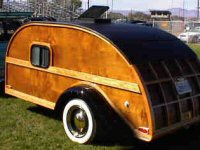That is cool! I hadn't seen that before. Real space saver and very practical to the application. I think a link to this post in the plumbing section may be in order (...but I don't look over there much, so maybe that's where you found it?)
Still thinking that you will build your own trailer/chassis? Big project in itself. Maybe you are an experienced metal worker and I just missed that part. Check yourself.
Re: thin 1 inch steel tube for the chassis; be careful. The tongue members and attachment points still need to be robust and the unity of the whole assembly needs to be well considered so that the loads are transferred well (spring mounts, stablizer jacks, safety chains, etc.). Stressed skin construction may be much more critical in making a "lightweight" or steel bird cage work. Also, consider what your fabrication capabilities are. Can you cut, form and weld square tubing, do you have the equipment and space to do this, or would you have to farm it out? It would be a major sub out in cost, and would put you out of a big portion of your build if you had to farm this part out. Your sense of self accomplishment might be diminished...there is a reason that we build these ourselves rather than just buying a commercial unit. There is nothing wrong with that if it suits your wants and needs, and is within budget, but I am getting a sense that you are looking for something a bit more basic and maybe are just falling into the new TD enthusiasm trap of wanting high tech, cutting edge, all the whistles and bells. Coming from someone that jumped into the deep end of the pool on his first build, my advice is to keep the first one simple and "get 'er done".
Farming out a major portion of your build would mean relying on someone else to commit to your schedule. Some shops have a hard time doing this, especially on a budget project that won't necessarily stay a priority for them. In hot rod terms this is called "body shop purgatory"; projects get started and take forever to complete.
Will a steel frame really be lighter than other methods that might suit your abilities better. Look at GPW's little camo foamie build nested into the big Thrifty Foamie thread...incredibly simple, small, very light, weather proof, could go on an inexpensive readymade trailer that is easy to find new or used on CL, can be built quickly, and would be easy to modify to your profile and hatch design. Easy to decorate in your unique style.
Did you study Andrew's (Angib's) trailer frame guidelines? Lot's of experience there.
That being said, if a light weight tubular construction is w/in your capabilities, both in design and fab, then “Wahoo”

go for it.

My advice is to keep studying what others have done, and don't assume that you can "cut and paste" from one design to another. Understand why something works, then apply it to your own design. Many of the big engineering disasters in history happen when people make "field changes" w/o fully understanding a design, or when working on the cutting edge of technology without understanding all of the unknowns (e.g. using 1x spars flat on a 6 wide and getting roof sag, or same for hatch ribs on a monster hatch and getting twist..."I don't understand it, I did it just like everyone else did").
Remember this, regardless of weight, the further apart the outer "fibers" of a given part are the stronger that part will be exponentially, so the 2 inch tube might weigh a little more than the 1 inch, but it will be much more than twice as strong over the same span (look up moment of inertia).
Oh heck, here's a snipet from wiki,
"The moment of inertia of an object about a given axis describes how difficult it is to change its angular motion about that axis. Therefore, it encompasses not just how much mass the object has overall, but how far each bit of mass is from the axis. The further out the object's mass is, the more rotational inertia the object has, and the more rotational force (torque, the force multiplied by its distance from the axis of rotation) is required to change its rotation rate."In other words, structural members that have the mass further away from the center axis will always be stronger in bending than a member with the same mass located closer to the load axis. That's why tubing is stronger for its weight than bar that weighs the same; the mass is further out from the center axis. On the side walls, provided that they are tied into the trailer frame uniformly, you create a really deep beam with the outer fibers several feet apart, but what about that rear hatch where the rear cross member is basically unsupported over the width of your trailer? Take a 4 ft long piece of 1x sq tube 1/16 thick, support it on the ends and bounce a heavy cooler full of ice and beverages off it a couple of hundred (neigh thousand) times. Maybe I'm just exaggerating to make a point.

There are success stories out there (

) so it is not all doom and gloom. Be informed. Read. Learn. Have fun!
When you get closer, post a dimensioned drawing up on the trailer forum and you will get plenty of help.


 Here are both options:
Here are both options:




 Fred
Fred
 Thanks for trying to help me!
Thanks for trying to help me!

 because my brain thinks up more possibilities than I can keep up with and that my TV can haul.
because my brain thinks up more possibilities than I can keep up with and that my TV can haul. go for it.
go for it.